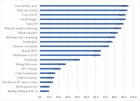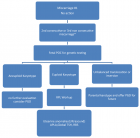Abstract
Research Article
Antifungal Efficacy of Panchgavya Formulations against Rhizoctonia solani: An Incitant of Rice Sheath Blight
JR Pandya* and JV Patel
Published: 02 October, 2024 | Volume 8 - Issue 3 | Pages: 118-120
The main rice-grown crop was found severely affected by sheath blight in the south Gujarat region. Sheath blight of rice symptoms were noticed on leaf blades and the sheath just above the water level. The isolation was done from infected parts and purified by the hyphal tip method on PDA which was maintained at 4 oC. The seven different panchgavya formulations of five cow products such as cow urine, dung, curd, ghee, and milk that designed as PG1, PG2, PG3, PG4, PG5, PG6, and PG7. The PG against test pathogen Rhizoctonia solani in vitro condition by the poisoned food technique and that tested at 2, 4, 6, 8, and 10 percent concentrations. It was observed that panchgavya were able to suppress the growth of R. solani. Among the different formulations, PG1 was significantly effective at all concentrations as compared to other PG formulations against
R. solani.
Read Full Article HTML DOI: 10.29328/journal.jpsp.1001143 Cite this Article Read Full Article PDF
Keywords:
Panchgavya formulations; Rice; Sheath blight; Rhizoctonia solani
References
- Agricultural statistics at Glance, Directorate of Economics and Statistics. 2017;89. Available from: https://desagri.gov.in/wp-content/uploads/2021/04/Agricultural-Statistics-at-a-Glance-2017.pdf
- Natarajan K. Panchgavya – A manual. Mapusa, Goa, India: Other India Press; 2002:33.
- Sugha SK. Role of panchgavya in the management of major soil-borne fungal diseases of vegetable crops. Plant Dis Res. 2009;24(1):41-47. Available from: https://www.indianjournals.com/ijor.aspx?target=ijor:pdr&volume=24&issue=1&article=012
- Amalraj EL, Kumar GP, Ahmed SMH, Abdul R, Kishore N. Microbiological analysis of panchgavya, vermicompost, and FYM and their effect on plant growth promotion of pigeon pea (Cajanus cajan L.) in India. Org Agric. 2013;3(1):23-29. Available from: https://link.springer.com/article/10.1007/s13165-013-0042-2
- Dogra S. Antifungal potential of panchgavya against some soil-borne pathogens. M.Sc thesis, CSK Himachal Pradesh Krishi Vishvavidyalaya, Palampur; 2006. Available from: https://krishikosh.egranth.ac.in/items/58118466-ca51-490a-a588-4dd5d89ffe7f
- Vincent JM. Distortion of fungal hyphae in presence of certain inhibitors. Nature. 1947;159:850. Available from: https://www.nature.com/articles/159850b0
- Karthika SR, Sajeena A, Girija VK, John J, Heera G. Antifungal activities of organic preparations, botanicals, and non-hazardous chemicals against Rhizoctonia solani Kuhn causing sheath blight of rice. J Trop Agric. 2017;55(1):104-113. Available from: https://jtropag.kau.in/index.php/ojs2/article/view/485
- Ashlesha, Paul YS. Antifungal bioefficacy of organic inputs against fungal pathogens of bell pepper. Indian J Res. 2014;3(6):1-6. Available from: https://www.worldwidejournals.com/paripex/recent_issues_pdf/2014/June/June_2014_1402919293_dfcb6_2.pdf
Figures:
Similar Articles
-
Impact of Calcium Phosphate Nanoparticles on Rice PlantHrishikesh Upadhyaya*,Lutfa Begum,Bishal Dey,P K Nath,S K Panda. Impact of Calcium Phosphate Nanoparticles on Rice Plant. . 2017 doi: 10.29328/journal.jpsp.1001001; 1: 001-010
-
Physiological impact of Zinc nanoparticle on germination of rice (Oryza sativa L) seedUpadhyaya H*,Roy H,Shome S,Tewari S,Bhattacharya MK,Panda SK. Physiological impact of Zinc nanoparticle on germination of rice (Oryza sativa L) seed . . 2017 doi: 10.29328/journal.jpsp.1001008; 1: 062-070
-
Primer Pairs for Rice (Oryza sativa L.) Bisulfite Sequencing StudiesMehmet Karaca*,Ayse Gul Ince. Primer Pairs for Rice (Oryza sativa L.) Bisulfite Sequencing Studies. . 2018 doi: 10.29328/journal.jpsp.1001024; 2: 091-098
-
Causal agents of Post-harvest Rot of Pumpkin (Cucurbita pepo L.) and their control using Indigenous Practices in Hong, Adamawa StateAnjili SM*,Kazi N,Chimbekujwo IB. Causal agents of Post-harvest Rot of Pumpkin (Cucurbita pepo L.) and their control using Indigenous Practices in Hong, Adamawa State. . 2019 doi: 10.29328/journal.jpsp.1001033; 3: 062-066
-
Comprehensive phenotypic characterization and genetic distinction of distinct goosegrass (Eleusine indica L. Gaertn.) ecotypesRobert A Kerr*,Tatyana Zhebentyayeva,Christopher Saski,Lambert B McCarty. Comprehensive phenotypic characterization and genetic distinction of distinct goosegrass (Eleusine indica L. Gaertn.) ecotypes. . 2019 doi: 10.29328/journal.jpsp.1001038; 3: 095-100
-
Potential of Pleurotus sajor-caju compost for controlling Meloidogyne incognita and improve nutritional status of tomato plantsSherin FA Awd Allah*,Doaa M Mostafa,Eman FA Awad-Allah. Potential of Pleurotus sajor-caju compost for controlling Meloidogyne incognita and improve nutritional status of tomato plants. . 2019 doi: 10.29328/journal.jpsp.1001042; 3: 118-127
-
Silicon rates and beneficial microorganism on blast suppression and productivity of upland riceAlan Carlos Alves de Souza*,Eduardo Alves,Marta Cristina Corsi de Filippi,Adriano Stephan Nascente,Anne Sitarama Prabhu. Silicon rates and beneficial microorganism on blast suppression and productivity of upland rice. . 2021 doi: 10.29328/journal.jpsp.1001057; 5: 020-027
-
Mitigation and adaptation to climate change of plant pathogensFrancesco Lops*. Mitigation and adaptation to climate change of plant pathogens. . 2022 doi: 10.29328/journal.jpsp.1001082; 6: 101-102
-
Characterization of senegalese races of Xanthomonas oryzae PV. oryzae to identify resistance genes to useTall H*,Tékété C,Comte A,Noba K,Hutin M,Szurek B,Verdier V,Cunnac S. Characterization of senegalese races of Xanthomonas oryzae PV. oryzae to identify resistance genes to use. . 2022 doi: 10.29328/journal.jpsp.1001087; 6: 135-145
-
Control of rice bakanae disease by seed dressing with mixed solution of fludioxonil, metalaxyl-M and azoxystrobinDeng Chen,Qi-Juan Hu,Xiao-Feng Chen*. Control of rice bakanae disease by seed dressing with mixed solution of fludioxonil, metalaxyl-M and azoxystrobin. . 2023 doi: 10.29328/journal.jpsp.1001096; 7: 001-007
Recently Viewed
-
Potter Syndrome: A case studyAnestakis D*,Konstantinidou,Nikolaou A,Moumou G,Karakasi MV,Pavlidis P,Chatzifotiou E. Potter Syndrome: A case study. J Forensic Sci Res. 2017: doi: 10.29328/journal.jfsr.1001007; 1: 063-067
-
Atypical Anti-GBM with ANCA Vasculitis- A Rarest of the Rare Entity: Index Case from Eastern IndiaGopambuj Singh Rathod*, Atanu Pal, Pallavi Mahato, Aakash Roy, Debroop Sengupta, Muzzamil Ahmad. Atypical Anti-GBM with ANCA Vasculitis- A Rarest of the Rare Entity: Index Case from Eastern India. J Clini Nephrol. 2024: doi: 10.29328/journal.jcn.1001139; 8: 124-126
-
Strengthening Healthcare Delivery in the Democratic Republic of Congo through Adequate Nursing WorkforceMin Kyung Shin, Tshibambe N Tshimbombu*. Strengthening Healthcare Delivery in the Democratic Republic of Congo through Adequate Nursing Workforce. Clin J Nurs Care Pract. 2024: doi: 10.29328/journal.cjncp.1001051; 8: 007-010
-
Poor Diet Leading to the Increasing Risk of Atherosclerosis in the WorldBijaya Bhusal*. Poor Diet Leading to the Increasing Risk of Atherosclerosis in the World. J Cardiol Cardiovasc Med. 2024: doi: 10.29328/journal.jccm.1001195; 9: 142-147
-
The therapeutic impact of the interaction between horses and patients with mental disorders: Veterinary and psychodynamic reflexions in the clinical application of equine assisted therapyGeorgios Avliotis,Anastasia Xecotea*. The therapeutic impact of the interaction between horses and patients with mental disorders: Veterinary and psychodynamic reflexions in the clinical application of equine assisted therapy. Insights Vet Sci. 2022: doi: 10.29328/journal.ivs.1001037; 6: 017-018
Most Viewed
-
Evaluation of Biostimulants Based on Recovered Protein Hydrolysates from Animal By-products as Plant Growth EnhancersH Pérez-Aguilar*, M Lacruz-Asaro, F Arán-Ais. Evaluation of Biostimulants Based on Recovered Protein Hydrolysates from Animal By-products as Plant Growth Enhancers. J Plant Sci Phytopathol. 2023 doi: 10.29328/journal.jpsp.1001104; 7: 042-047
-
Sinonasal Myxoma Extending into the Orbit in a 4-Year Old: A Case PresentationJulian A Purrinos*, Ramzi Younis. Sinonasal Myxoma Extending into the Orbit in a 4-Year Old: A Case Presentation. Arch Case Rep. 2024 doi: 10.29328/journal.acr.1001099; 8: 075-077
-
Feasibility study of magnetic sensing for detecting single-neuron action potentialsDenis Tonini,Kai Wu,Renata Saha,Jian-Ping Wang*. Feasibility study of magnetic sensing for detecting single-neuron action potentials. Ann Biomed Sci Eng. 2022 doi: 10.29328/journal.abse.1001018; 6: 019-029
-
Pediatric Dysgerminoma: Unveiling a Rare Ovarian TumorFaten Limaiem*, Khalil Saffar, Ahmed Halouani. Pediatric Dysgerminoma: Unveiling a Rare Ovarian Tumor. Arch Case Rep. 2024 doi: 10.29328/journal.acr.1001087; 8: 010-013
-
Physical activity can change the physiological and psychological circumstances during COVID-19 pandemic: A narrative reviewKhashayar Maroufi*. Physical activity can change the physiological and psychological circumstances during COVID-19 pandemic: A narrative review. J Sports Med Ther. 2021 doi: 10.29328/journal.jsmt.1001051; 6: 001-007

HSPI: We're glad you're here. Please click "create a new Query" if you are a new visitor to our website and need further information from us.
If you are already a member of our network and need to keep track of any developments regarding a question you have already submitted, click "take me to my Query."






















































































































































